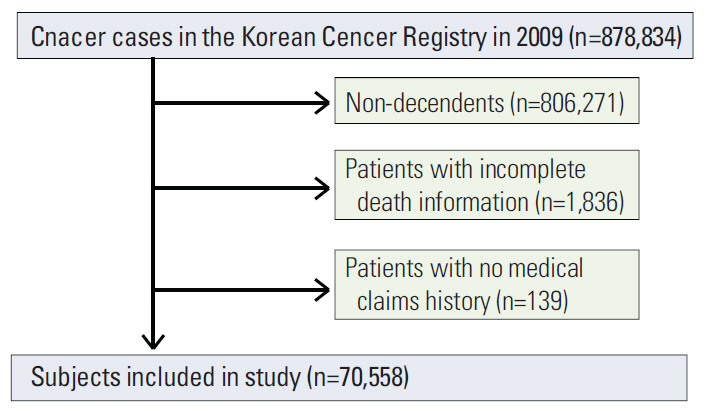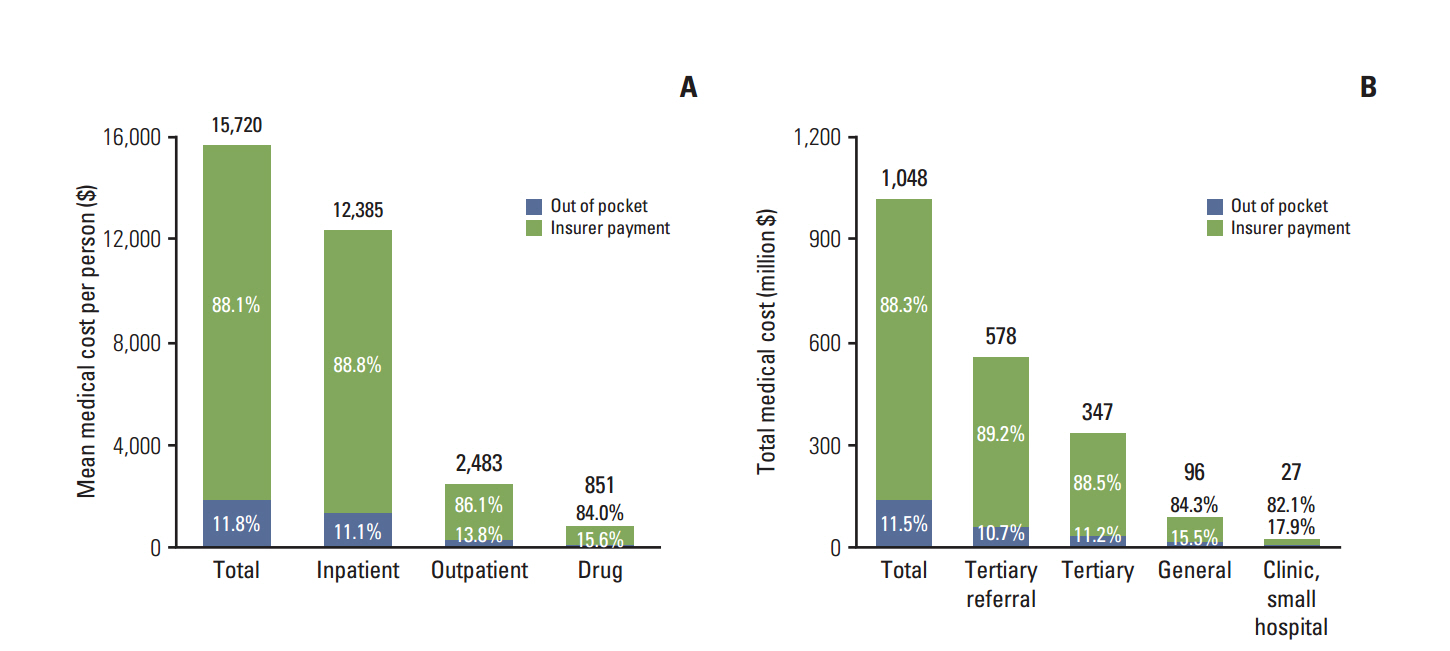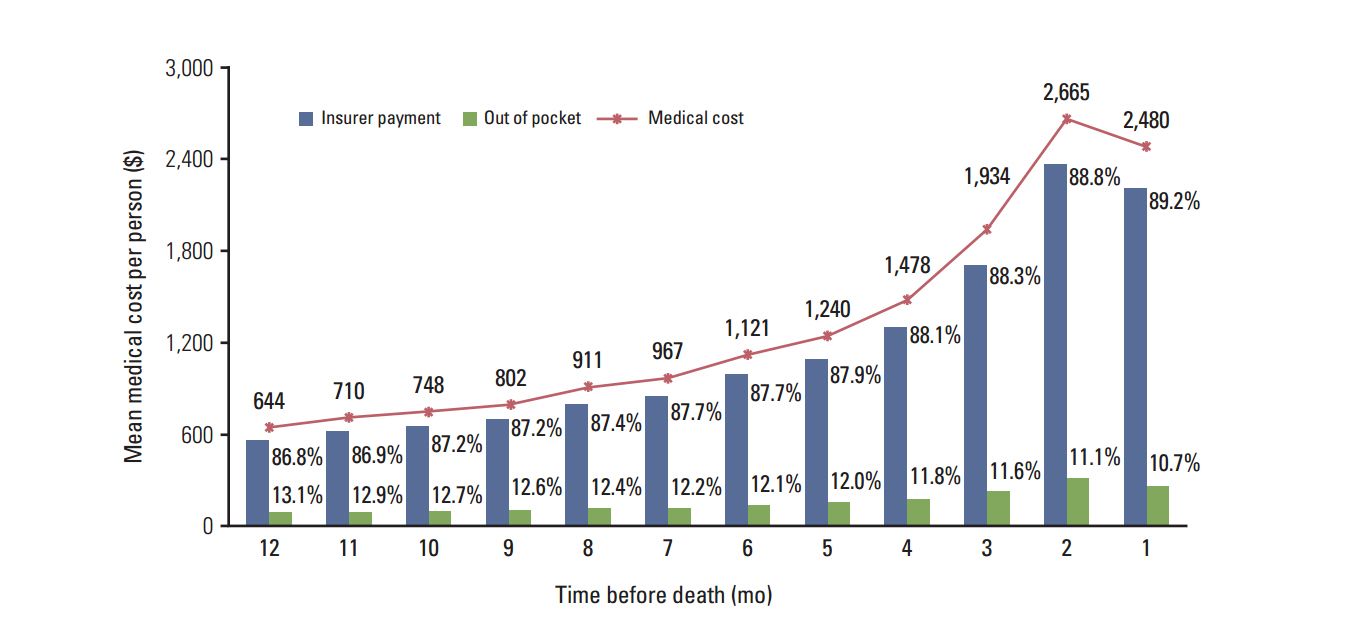Cancer Res Treat.
2016 Jan;48(1):365-375. 10.4143/crt.2014.088.
Medical Costs and Healthcare Utilization among Cancer Decedents in the Last Year of Life in 2009
- Affiliations
-
- 1National Cancer Control Institute, National Cancer Center, Goyang, Korea.
- 2Department of Family Medicine and Health Promotion Center, Seoul National University Hospital, Seoul National University College of Medicine, Seoul, Korea.
- 3Cancer Survivorship Clinic, Seoul National University Cancer Hospital, Seoul National University College of Medicine, Seoul, Koarea.
- 4Chungbuk Regional Cardiocerebrovascular Center, Chungbuk National University Hospital, Chungbuk National University College of Medicine, Cheongju, Korea. letter.sykim@gmail.com
- 5Graduate School of Health Science Business Convergence, Chungbuk National University, Cheongju, Korea. jonghyock@chungbuk.ac.kr
- 6Department of Preventive Medicine, Chungbuk National University College of Medicine, Cheongju, Korea.
- KMID: 2152295
- DOI: http://doi.org/10.4143/crt.2014.088
Abstract
- PURPOSE
The purpose of this study was to evaluate the cancer care cost during the last year of life of patients in Korea.
MATERIALS AND METHODS
We studied the breakdown of spending on the components of cancer care. Cancer decedents in 2009 were identified from the Korean Central Cancer Registry and linked with the Korean National Health Insurance Claims Database. The final number of patients included in the study was 70,558.
RESULTS
In 2009, the average cancer care cost during the last year of life was US $15,720. Patients under age 20 spent US $53,890 while those 70 or over spent US $11,801. Those with leukemia incurred the highest costs (US $43,219) while bladder cancer patients spent the least (US $13,155). General costs, drugs other than analgesics, and test fees were relatively high (29.7%, 23.8%, and 20.7% of total medical costs, respectively). Analgesic drugs, rehabilitation, and psychotherapy were still relatively low (4.3%, 0.7%, and 0.1%, respectively). Among the results of multiple regression analysis, few were notable. Age was found to be negatively related to cancer care costs while income level was positively associated. Those classified under distant Surveillance, Epidemiology, and End Results stages of cancer and higher comorbidity level also incurred higher cancer care costs.
CONCLUSION
Average cancer care costs varied significantly by patient characteristics. However, the study results suggest an underutilization of support services likely due to lack of alternative accommodations for terminal cancer patients. Further examination of utilization patterns of healthcare resources will help provide tailored evidence for policymakers in efforts to reduce the burdens of cancer care.
Keyword
MeSH Terms
Figure
Cited by 1 articles
-
The Effect of Hospice Consultation on Aggressive Treatment of Lung Cancer
Shin Hye Yoo, Bhumsuk Keam, Miso Kim, Tae Min Kim, Dong-Wan Kim, Dae Seog Heo
Cancer Res Treat. 2018;50(3):720-728. doi: 10.4143/crt.2017.169.
Reference
-
References
1. Yabroff KR, Warren JL, Brown ML. Costs of cancer care in the USA: adescriptive review. Nat Clin Pract Oncol. 2007; 4:643–56.2. Mariotto AB, Yabroff KR, Shao Y, Feuer EJ, Brown ML. Projections of the cost of cancer care in the United States: 2010-2020. J Natl Cancer Inst. 2011; 103:117–28.
Article3. Statistics Korea. Annual report on the cause of death statistics. Daejeon: Korea National Statistical Office;2007.4. National Cancer Center, Ministry of Health and Welfare. Cancer facts and figures 2013 in the Republic of Korea. Goyang: National Cancer Center;2013.5. Yabroff KR, Lund J, Kepka D, Mariotto A. Economic burden of cancer in the United States: estimates, projections, and future research. Cancer Epidemiol Biomarkers Prev. 2011; 20:2006–14.
Article6. Chastek B, Harley C, Kallich J, Newcomer L, Paoli CJ, Teitelbaum AH. Healthcare costs for patients with cancer at the end of life. J Oncol Pract. 2012; 8:75s–80s.7. Hogan C, Lunney J, Gabel J, Lynn J. Medicare beneficiaries’ costs of care in the last year of life. Health Aff (Millwood). 2001; 20:188–95.
Article8. Yi JJ, Yoo WK, Kim SY, Kim KK, Yi SW. Medical expenses by site of cancer and survival time among cancer patients in the last one year of life. J Prev Med Public Health. 2005; 38:9–15.9. Choo SY, Lee SY, Kim CW, Kim SY, Yoon TH, Shin HR, et al. Educational differences in health care utilization in the last year of life among South Korean cancer patients. J Prev Med Public Health. 2007; 40:36–44.
Article10. Choi KS, You CH, Lee KH, Kim CY, Heo DS, Yun YH. Comparison of medical care cost between hospice care and conventional care in the last year of life. Korean J Health Policy Adm. 2005; 15:1–15.11. Yoon TH, Lee SY, Kim CW, Kim SY, Jeong BG, Park HK. In equalities in medical care utilization by South Korean cancer patients according to income: a retrospective cohort study. Int J Health Serv. 2011; 41:51–66.12. Dinan MA, Curtis LH, Hammill BG, Patz EF Jr, Abernethy AP, Shea AM, et al. Changes in the use and costs of diagnostic imaging among Medicare beneficiaries with cancer, 1999-2006. JAMA. 2010; 303:1625–31.
Article13. Jung KW, Park S, Kong HJ, Won YJ, Lee JY, Seo HG, et al. Cancer statistics in Korea: incidence, mortality, survival, and prevalence in 2009. Cancer Res Treat. 2012; 44:11–24.
Article14. Kim SY, Park JH, Kim SG, Woo HK, Park JH, Kim Y, et al. Disparities in utilization of high-volume hospitals for cancer surgery: results of a Korean population-based study. Ann Surg Oncol. 2010; 17:2806–15.
Article15. National Cancer Insitute. Review: summary staging [Internet]. Bethesda, MD: National Cancer Insitute;2014. [cited 2014 Feb 2]. Available from: http://training.seer.cancer.gov/ss2k/staging/review.html.16. Brown ML, Lipscomb J, Snyder C. The burden of illness of cancer: economic costand quality of life. Annu Rev Public Health. 2001; 22:91–113.17. Yabroff KR, Mariotto AB, Feuer E, Brown ML. Projections of the costs associated with colorectal cancer care in the United States, 2000-2020. Health Econ. 2008; 17:947–59.
Article18. Athas WF, Adams-Cameron M, Hunt WC, Amir-Fazli A, Key CR. Travel distance to radiation therapy and receipt of radiotherapy following breast-conserving surgery. J Natl Cancer Inst. 2000; 92:269–71.
Article19. Kim SG, Park WS. Out-of-pocket health expenditures among adult Koreans with cancer. Korean J Med. 2006; 70:61–8.20. Keam B, Oh DY, Lee SH, Kim DW, Kim MR, Im SA, et al. Aggressiveness of cancer-care near the end-of-life in Korea. Jpn J Clin Oncol. 2008; 38:381–6.
Article21. Fawzy FI. Psychosocial interventions for patients with cancer: what works and what doesn’t. Eur J Cancer. 1999; 35:1559–64.22. Yoshioka H. Rehabilitation for the terminal cancer patient. Am J Phys Med Rehabil. 1994; 73:199–206.23. Sharp L, Timmons A. The financial impact of a cancer diagnosis. Cork, IR: Irish Cancer Society;2010.24. Yang Y, Czernin J. Contribution of imaging to cancer care costs. J Nucl Med. 2011; 52 Suppl 2:86S–92S.
Article25. Brown ML, Riley GF, Schussler N, Etzioni R. Estimating health care costs related to cancer treatment from SEER-Medicare data. Med Care. 2002; 40(8 Suppl):IV-104–17.
Article
- Full Text Links
- Actions
-
Cited
- CITED
-
- Close
- Share
- Similar articles
-
- Long-Term Care Utilization among End-of-Life Older Adults in Korea: Characteristics and Associated Factors
- Trends in End-of-Life Resource Utilization and Costs among Prostate Cancer Patients from 2006 to 2015: A Nationwide Population-Based Study
- Influencing Factors of Transportation Costs Regarding Healthcare Service Utilization in Korea
- Costs of Initial Cancer Care and its Affecting Factors
- Healthcare Costs for Chronic Hepatitis C in South Korea from 2009 to 2013: An Analysis of the National Health Insurance Claims' Data





